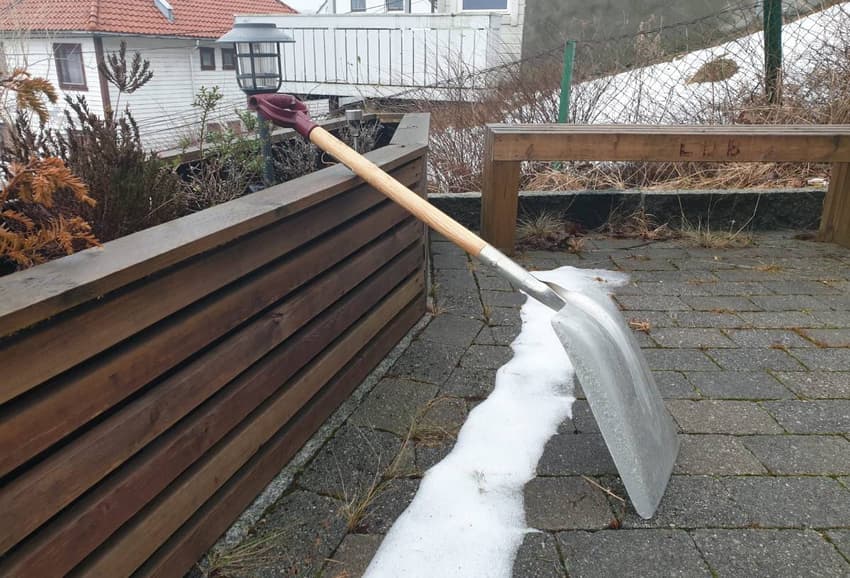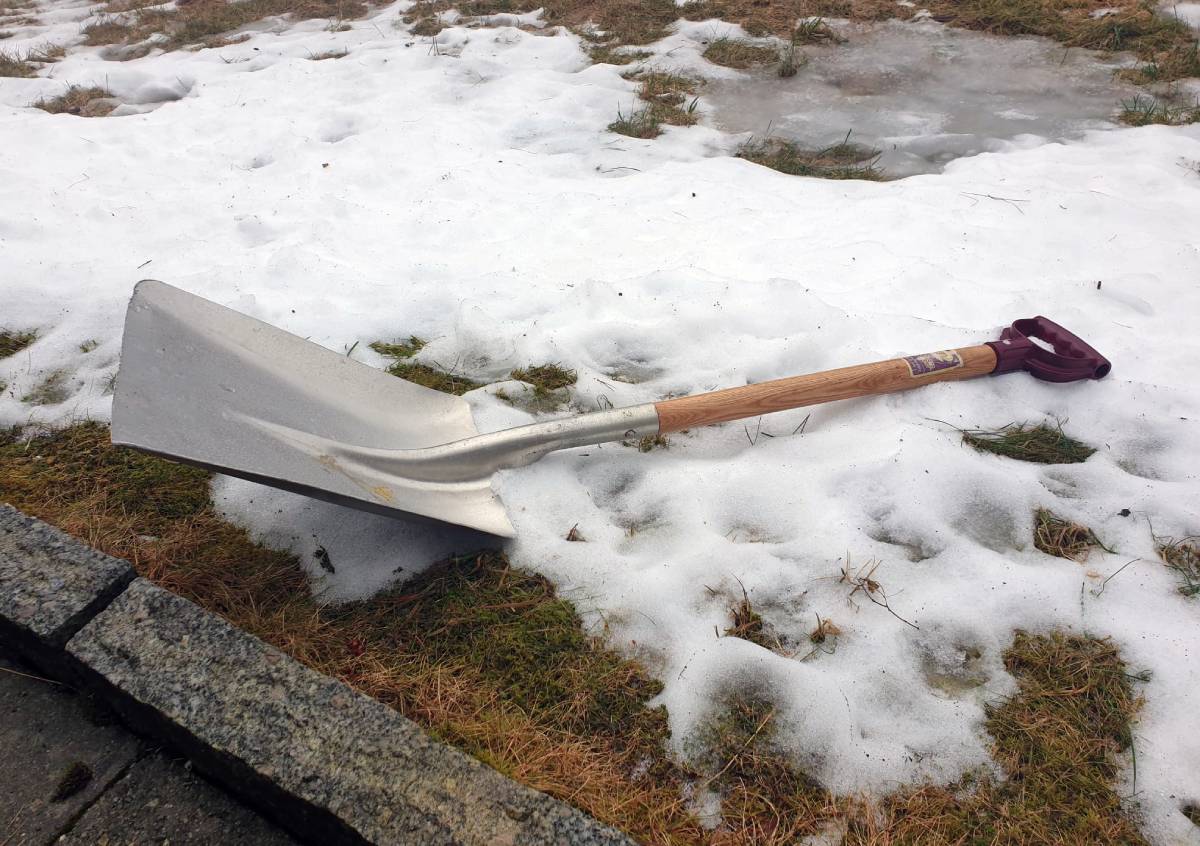Are you legally required to shovel snow on your property in Norway?

In Norway, where winter often means streets and buildings covered in snow and ice, the question of who is responsible for shovelling snow is a common concern among homeowners, tenants, and landlords.
Come winter, most people who move to Norway have to start seriously thinking about the harsh weather conditions – especially if they don't live in the country's southern parts.
Icy and slippery roads and passages, disrupted public transport, and a thick blanket of snow are just some of the characteristic occurrences associated with the season.
READ MORE: Five things you need to learn to love about winter in Norway
The day after your first intense snowstorm in Norway - once the idyllic feeling of landscapes covered in snow starts to fade - you'll be faced with a grim reality – someone needs to get out in the cold and deal with the snow and ice that are obstructing passages and posing a safety risk.
But are you obligated to do it yourself? And do different rules apply to tenants and homeowners?
The rules regulating snow shovelling
The answer to these questions isn't straightforward, but it's not complicated. In essence, it depends on your local regulations, the type of property you reside in, and – if you're a tenant – your lease agreements.
Homeowners
As a homeowner (huseier in Norwegian), you generally can decide whether and when you want to shovel snow around your property.
However, if your property borders a public area, such as a pavement or a road, local police regulations typically require property owners to spread and remove snow and ice.
READ MORE: How to dress for the cold weather in Norway
The primary objective of these regulations is to ensure that snow and ice do not pose a danger or inconvenience to pedestrians and motorists.
These rules and regulations regarding snow removal can be found in your local police statutes, which you should be able to find via a quick Google search.
Tenants and landlords
In rental properties, the initial responsibility for snow removal often falls on the landlord (Norwegian: utleier).
However, the Norwegian Tenancy Act allows landlords and tenants to agree on different arrangements for maintenance responsibilities, including snow removal.
If the lease agreement specifies that the tenant is responsible for shovelling snow, then the tenant (Norwegian: leietaker) becomes responsible for this task.
In cases where the landlord and tenant live in the same building, they may divide the responsibilities, such as the tenant shovelling their entrance while the landlord handles other areas.

Few things unite or divide a Norwegian neighborhood quite like winter snow shoveling. Photo by: Robin-Ivan Capar / The Local Norway
Housing associations
For residents of housing associations (Norwegian: borettslag), the responsibility for snow removal typically falls on the board of the association, according to the Huseierne homeowner interest organisation.
Common areas such as roads, entrances, and patios fall under the board's jurisdiction, and they are tasked with managing snow shovelling.
READ MORE: How much snow will there be in Norway in 2050?
The board can also hire a professional snow removal company or establish bylaws and house rules that assign snow removal responsibilities among residents.
In the case of housing associations consisting of single-family housing, residents might be individually responsible for shovelling outside their housing units, but this must be clearly defined in the association's rules.
Grey area: The maintenance of the internal parts of the balcony is generally your responsibility, while the outer parts of balconies are usually considered part of the façade and treated as common areas.
Avoiding neighbourhood disputes
Regardless of who is responsible for snow removal, it is important to dispose of snow appropriately.
Dumping snow in public places or onto neighbouring properties without consent is illegal - the Norwegian Neighborhood Act prohibits actions that inconvenience neighbouring properties.
Therefore, it is best to cooperate with your neighbours to find a suitable place for snow disposal to prevent arguments.
Safety precautions
In addition to the general duty described in the Norwegian regulations (such as the Housing Association Act), local police statutes often include specific snow and ice removal provisions.
For instance, in Oslo Municipality, there are stringent rules regarding removing dangerous snow and ice from roofs to prevent accidents caused by falling icicles or snow.
Therefore, the board of housing associations should ensure compliance with these regulations to protect both residents and property because failure to do so can result in hefty fines if accidents occur due to negligence.
Who's responsible in case of an injury?
If someone slips and gets injured due to ice or snow on your property, the property owner may be held liable for damages if it can be proven that the owner's negligence caused the injury, according to the homeowner association BoligMentoren.
Negligence can include failing to properly clear the area, as required by the local police statutes in your area.
Comments
See Also
Come winter, most people who move to Norway have to start seriously thinking about the harsh weather conditions – especially if they don't live in the country's southern parts.
Icy and slippery roads and passages, disrupted public transport, and a thick blanket of snow are just some of the characteristic occurrences associated with the season.
READ MORE: Five things you need to learn to love about winter in Norway
The day after your first intense snowstorm in Norway - once the idyllic feeling of landscapes covered in snow starts to fade - you'll be faced with a grim reality – someone needs to get out in the cold and deal with the snow and ice that are obstructing passages and posing a safety risk.
But are you obligated to do it yourself? And do different rules apply to tenants and homeowners?
The rules regulating snow shovelling
The answer to these questions isn't straightforward, but it's not complicated. In essence, it depends on your local regulations, the type of property you reside in, and – if you're a tenant – your lease agreements.
Homeowners
As a homeowner (huseier in Norwegian), you generally can decide whether and when you want to shovel snow around your property.
However, if your property borders a public area, such as a pavement or a road, local police regulations typically require property owners to spread and remove snow and ice.
READ MORE: How to dress for the cold weather in Norway
The primary objective of these regulations is to ensure that snow and ice do not pose a danger or inconvenience to pedestrians and motorists.
These rules and regulations regarding snow removal can be found in your local police statutes, which you should be able to find via a quick Google search.
Tenants and landlords
In rental properties, the initial responsibility for snow removal often falls on the landlord (Norwegian: utleier).
However, the Norwegian Tenancy Act allows landlords and tenants to agree on different arrangements for maintenance responsibilities, including snow removal.
If the lease agreement specifies that the tenant is responsible for shovelling snow, then the tenant (Norwegian: leietaker) becomes responsible for this task.
In cases where the landlord and tenant live in the same building, they may divide the responsibilities, such as the tenant shovelling their entrance while the landlord handles other areas.

Housing associations
For residents of housing associations (Norwegian: borettslag), the responsibility for snow removal typically falls on the board of the association, according to the Huseierne homeowner interest organisation.
Common areas such as roads, entrances, and patios fall under the board's jurisdiction, and they are tasked with managing snow shovelling.
READ MORE: How much snow will there be in Norway in 2050?
The board can also hire a professional snow removal company or establish bylaws and house rules that assign snow removal responsibilities among residents.
In the case of housing associations consisting of single-family housing, residents might be individually responsible for shovelling outside their housing units, but this must be clearly defined in the association's rules.
Grey area: The maintenance of the internal parts of the balcony is generally your responsibility, while the outer parts of balconies are usually considered part of the façade and treated as common areas.
Avoiding neighbourhood disputes
Regardless of who is responsible for snow removal, it is important to dispose of snow appropriately.
Dumping snow in public places or onto neighbouring properties without consent is illegal - the Norwegian Neighborhood Act prohibits actions that inconvenience neighbouring properties.
Therefore, it is best to cooperate with your neighbours to find a suitable place for snow disposal to prevent arguments.
Safety precautions
In addition to the general duty described in the Norwegian regulations (such as the Housing Association Act), local police statutes often include specific snow and ice removal provisions.
For instance, in Oslo Municipality, there are stringent rules regarding removing dangerous snow and ice from roofs to prevent accidents caused by falling icicles or snow.
Therefore, the board of housing associations should ensure compliance with these regulations to protect both residents and property because failure to do so can result in hefty fines if accidents occur due to negligence.
Who's responsible in case of an injury?
If someone slips and gets injured due to ice or snow on your property, the property owner may be held liable for damages if it can be proven that the owner's negligence caused the injury, according to the homeowner association BoligMentoren.
Negligence can include failing to properly clear the area, as required by the local police statutes in your area.
Join the conversation in our comments section below. Share your own views and experience and if you have a question or suggestion for our journalists then email us at [email protected].
Please keep comments civil, constructive and on topic – and make sure to read our terms of use before getting involved.
Please log in here to leave a comment.